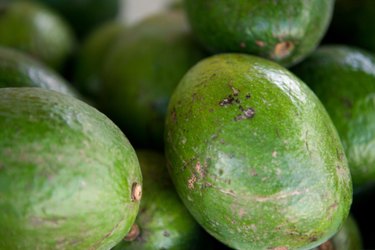
Avocados are exotic fruits that grow well in parts of Florida, California and Hawaii. They are thought to have originated in southern Mexico, though by the time European explorers arrived in the New World they were already cultivated from the Rio Grande Valley in what is now southern Texas to central Peru. Hass avocados -- among the bumpy-textured Guatemalan types sometimes known as alligator pears -- dominate the commercial market. But many other varieties exist, including a number of smooth-skinned green Mexican types. All avocados are most flavorful when fully ripe.
Bacon Avocado
Video of the Day
The Bacon avocado, among the smooth, green Mexican varieties, is a hybrid named for James Bacon of Orange County, California, who introduced it in 1954. Trees produce abundant round to oval, small to medium avocados that weigh up to 12 oz. Trees are hardy to about 25 degrees Fahrenheit and may tolerate even colder conditions in protected home orchard or garden microclimates. Fruits are available from late fall to midspring and have good flavor and texture, though aficionados say other varieties are superior.
Video of the Day
Stages of Ripeness
The California Avocado Commission recognizes five stages of ripeness for avocados. First comes the "hard" stage, typical for just-picked fruit. The next preripened stages are "preconditioned," when fruit can be eaten in three days if kept at room temperature; "breaking," when fruit has slight give to it and is two days from ripeness; and "firm ripe," when fruit yields to gentle pressure and will be fully ripe the following day. At the "ripe" stage, avocado flesh very easily gives under gentle pressure.
Bacon Avocado Ripeness
Unripe avocados are usually light to bright green, and ripe fruits may change from dark green to black -- a color change that reflects maturity. But some avocado varieties don't change color. Even among those that do, during certain times of the year fruit will darken due to maturity yet not be ripe, so color alone is not a sufficient guide to ripeness. According to the California Avocado Commission, when Bacon avocados are ripe, their thin green skin will darken slightly; more significantly, their flesh will give very easily under gentle pressure.
Bacon Avocado Alternatives
Lesser-known avocado varieties have similar hardiness as Bacon avocados and some say better flavor. The very vigorous Duke, which originated in 1912 in Bangor, California, is hardy to 22 degrees Fahrenheit and produces small but excellent fruit with high levels of oil. This variety is so successful at resisting both wind and root rot that it is often used as rootstock for other avocados. Another good thin-skinned variety is Ganter, California's oldest cultivar, dating to 1905. It is also very hardy. Once the standard for California's avocado industry, Fuerte is a tall variety that produces 1 lb. thin-skinned fruits, bearing a good crop every other year.